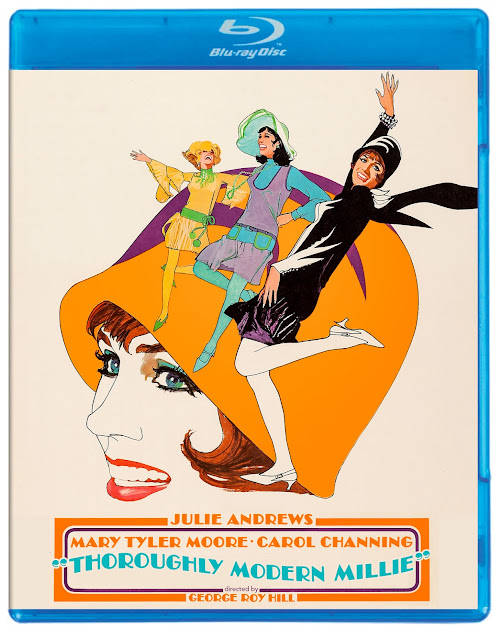Directed by George Roy Hill, Thoroughly Modern Millie (1967) stars Julie Andrews as the eponymous Millie. As a young woman living in New York City, Millie has big dreams. She sheds her out-of-date style for the new 1920s flapper look and sets her sights on a job so she can ultimately marry her boss and live a life of luxury and stability. Millie is staying at Mrs. Meers' (Beatrice Lillie) boardinghouse where the elevator requires its riders to tap dance for it to function and where a series of new tenants have mysteriously disappeared. Mrs. Meers is secretly running a sex trafficking ring with the help of a pair of Chinatown henchmen (Jack Soo and Pat Morita) who disguise themselves as launderers. She targets women who come to the city as orphans. Free of familial connections and with no one to miss them if they're gone, they're the perfect targets for Mrs. Meers to drug and sequester. Her new target is Miss Dorothy Brown (Mary Tyler Moore), a wide-eyed and naive young woman whom Millie quickly takes under her wing. Millie becomes the object of affection for paperclip salesman Jimmy (James Fox) but is adamant she will marry her boss Trevor Graydon (John Gavin) who really just has his sights on Dorothy. A series of events unfold including a wild party hosted by widowed millionaire Muzzy Van Hossmere (Carol Channing) and many attempts by Mrs. Meers to drug Dorothy. Will this quartet of love birds finally catch on to Mrs. Meers' machinations and save Dorothy before it's too late?
Thoroughly Modern Millie (1967) is a fun and lively musical that has a grand ole time with song, dance, costumes, color palettes and 1920s style and culture. It doesn't take itself too seriously which adds to the light and frothy feel. This was the first musical for director George Roy Hill (best known for his later films Butch Cassidy and the Sundance Kid and The Sting). He's quoted as saying "I wanted it to be a soufflé. I knew it had to stay afloat by its own mindless nonsense." And he definitely succeeded at that. The movie was produced by Ross Hunter who had made numerous big budget films for Universal Pictures including All That Heaven Allows (1955), Imitation of Life (1959), Pillow Talk (1959) and Flower Drum Song (1961). Hunter originally wanted to adapt the 1920s themed musical The Boy Friend but wasn't able to secure the rights so he decided to pursue the 1956 musical Thoroughly Modern Millie instead.
While the movie is not meant to be a wholly accurate portrayal of 1920s life, I was impressed on how many key cultural elements were shown that were indicative of the era. These include automobiles, aviation, (a reference to) automats, dance parties, '20s colloquialisms ("banana oil", "by jingo", etc), vaudeville and most notably "buildering" (the fad of climbing buildings that Harold Lloyd depicted in his 1923 silent comedy Safety Last!) There are references to silent films including various title cards which appear as thoughts for Millie when she breaks the third wall to deliver a quip to the audience.
My favorite visual element of the film is the changing color pallette. The set design and fashion appear in muted colors of white, black, grey and beige with a pop of a singular color. This statement color becomes the visual focal point of those scenes. We see green, yellow, orange, pink, red, black, blue, gold then purple and eventually there are more references to previous colors.
Even though the lighter elements dominate, Thoroughly Modern Millie is ultimately a problematic movie. A sex trafficking musical that features really harmful Asian stereotypes is not going to sit well with contemporary audiences. And it's not like these themes are minor ones that could easily be edited out of the musical. They're really ingrained into the overall story.
Thoroughly Modern Millie (1967) was a critical darling and a box office hit. Julie Andrews is at the top of her game and both Carol Channing and Mary Tyler Moore really shine in this musical. The film was nominated for seven academy awards including Best Actress in a Supporting Role for Carol Channing and Best Costume Design for Jean Louis. Elmer Bernstein earned the only win for the film with a Best Original Score Oscar. A sequel called The Jazz Babies was planned but never came to fruition.
The Roadshow Edition of Thoroughly Modern Millie (1967) complete with full overture, intermission and exit music is available on blu-ray from Kino Lorber. The movie has been fully restored in 4K by Universal Pictures. It really benefits from this restoration especially since color is such an important element in the movie. The Blu-ray disc also includes English subtitles, audio commentary by film historian Lee Gambin and art historian Ian McNally and various theatrical trailers.
Thank you to Kino Lorber for sending me a copy to review!

















































